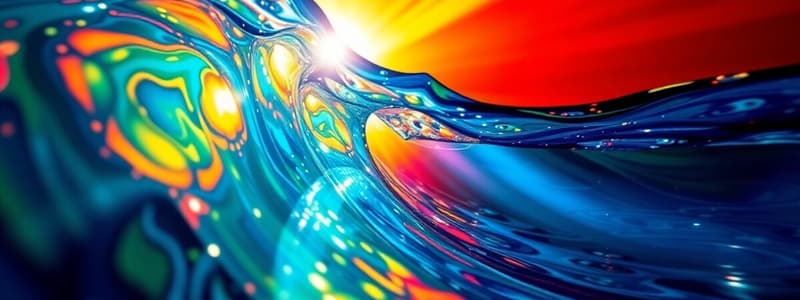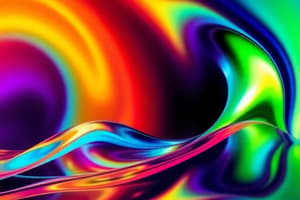Podcast
Questions and Answers
Why can we see objects when a room is lit?
Why can we see objects when a room is lit?
- Objects emit their own light.
- Transparent medium allows us to see things.
- Objects reflect light that falls on them, which is then received by our eyes. (correct)
- Light is absorbed by objects.
Light always travels in perfectly straight lines, regardless of the medium or any obstructions.
Light always travels in perfectly straight lines, regardless of the medium or any obstructions.
False (B)
What is the name for the bending of light around small objects?
What is the name for the bending of light around small objects?
Diffraction
A highly ______ surface, such as a mirror, reflects most of the light falling on it.
A highly ______ surface, such as a mirror, reflects most of the light falling on it.
Match the type of mirror with its description:
Match the type of mirror with its description:
What is the center of the reflecting surface of a spherical mirror called?
What is the center of the reflecting surface of a spherical mirror called?
The centre of curvature is a part of the mirror's reflecting surface.
The centre of curvature is a part of the mirror's reflecting surface.
Define the principal axis of a spherical mirror.
Define the principal axis of a spherical mirror.
For spherical mirrors of small apertures, the radius of curvature is equal to ______ times the focal length.
For spherical mirrors of small apertures, the radius of curvature is equal to ______ times the focal length.
Match the position of the object with the image formed on a concave mirror:
Match the position of the object with the image formed on a concave mirror:
For which object position does a concave mirror produce an enlarged, virtual, and erect image?
For which object position does a concave mirror produce an enlarged, virtual, and erect image?
When a ray of light passes through the centre of curvature of a concave mirror, it does not change its path.
When a ray of light passes through the centre of curvature of a concave mirror, it does not change its path.
State two uses of concave mirrors.
State two uses of concave mirrors.
Convex mirrors are commonly used as ______ mirrors in vehicles.
Convex mirrors are commonly used as ______ mirrors in vehicles.
Match the characteristics of images produced by convex mirrors:
Match the characteristics of images produced by convex mirrors:
According to the New Cartesian Sign Convention, where is the object always placed?
According to the New Cartesian Sign Convention, where is the object always placed?
All distances measured to the left of the pole (along –x axis) are taken as positive.
All distances measured to the left of the pole (along –x axis) are taken as positive.
State the mirror formula.
State the mirror formula.
Magnification produced by a spherical mirror is the ratio of the height of the ______ to the height of the object.
Magnification produced by a spherical mirror is the ratio of the height of the ______ to the height of the object.
Match the sign conventions for magnification with the image type:
Match the sign conventions for magnification with the image type:
What phenomenon causes the bottom of a tank of water to appear raised?
What phenomenon causes the bottom of a tank of water to appear raised?
Light always travels at the same speed, regardless of the medium it is traveling through.
Light always travels at the same speed, regardless of the medium it is traveling through.
What is the name for the phenomenon where light changes direction as it passes from one transparent medium to another?
What is the name for the phenomenon where light changes direction as it passes from one transparent medium to another?
The ratio of the sine of the angle of incidence to the sine of the angle of refraction is a ______, for a given pair of media.
The ratio of the sine of the angle of incidence to the sine of the angle of refraction is a ______, for a given pair of media.
Match the refractive index term with its description:
Match the refractive index term with its description:
What is meant by the term 'optically denser' in the context of refraction?
What is meant by the term 'optically denser' in the context of refraction?
A lens is bounded by at least two spherical surfaces.
A lens is bounded by at least two spherical surfaces.
What is the central point of a lens called?
What is the central point of a lens called?
A ______ lens converges light rays, while a concave lens diverges light rays.
A ______ lens converges light rays, while a concave lens diverges light rays.
Match the lens type with its focal length sign (according to sign convention):
Match the lens type with its focal length sign (according to sign convention):
Flashcards
Diffraction of Light
Diffraction of Light
The bending of light around obstacles; occurs when the obstacle is very small.
Mirror
Mirror
A surface that reflects most of the light falling on it, creating an image.
Law of Reflection
Law of Reflection
States that the angle of incidence equals the angle of reflection.
Lateral Inversion
Lateral Inversion
Signup and view all the flashcards
Concave Mirror
Concave Mirror
Signup and view all the flashcards
Convex Mirror
Convex Mirror
Signup and view all the flashcards
Pole of a Spherical Mirror
Pole of a Spherical Mirror
Signup and view all the flashcards
Center of Curvature
Center of Curvature
Signup and view all the flashcards
Radius of Curvature
Radius of Curvature
Signup and view all the flashcards
Principal Axis
Principal Axis
Signup and view all the flashcards
Principal Focus
Principal Focus
Signup and view all the flashcards
Focal Length
Focal Length
Signup and view all the flashcards
Aperture
Aperture
Signup and view all the flashcards
New Cartesian Sign Convention
New Cartesian Sign Convention
Signup and view all the flashcards
Mirror Formula
Mirror Formula
Signup and view all the flashcards
Magnification
Magnification
Signup and view all the flashcards
Refraction of Light
Refraction of Light
Signup and view all the flashcards
Snell's Law of Refraction
Snell's Law of Refraction
Signup and view all the flashcards
Refractive Index
Refractive Index
Signup and view all the flashcards
convex lens
convex lens
Signup and view all the flashcards
Power of a Lens
Power of a Lens
Signup and view all the flashcards
Study Notes
- In a dark room it is impossible to see
- In lit rooms, lights reflects off objects
- Reflected light enables people to see things
Light Phenomena
- Light transmits through transparent mediums enabling sight
- Light phenomena includes image formation by mirrors, twinkling stars, rainbows, and bending of light
Light Travel
- Light travels in straight lines
- A small light source casts a sharp shadow on an opaque object, thus illustrating this straight path of light, which is indicated as a ray of light
Diffraction of Light
- Light bends around opaque objects if the object is very small
- Straight-line treatment of optics using rays fails when an object is very small
- To explain diffraction, light is considered as waves
Wave Theory
- The wave theory of light becomes inadequate for treating the interaction of light with matter
- Light behaves somewhat like a stream of particles
- Modern quantum theory reconciles particle properties of light with wave nature, defining light as neither a wave nor a particle
Chapter Focus
- Reflection and refraction of light, using straight-line propagation
- Reflection of light by spherical mirrors, refraction of light, and their application in real-life situations will be discussed
Reflection of Light
- A highly polished surface reflects most of the light falling on it, such as a mirror
Laws of Reflection
- Angle of incidence equals the angle of reflection
- Incident ray, normal to the mirror at the point of incidence, and reflected ray all lie in the same plane
Plane Mirrors
- Plane mirrors produce virtual and erect images
- Image size equals object size in plane mirrors
- Image is as far behind the mirror as the object is in front
- The image in plane mirrors is laterally inverted
Curved Mirrors
- Curved surfaces can be considered as curved mirrors
- Spherical mirrors are curved mirrors, with a reflecting surface forming a part of the surface of a sphere
Spherical Mirrors
- A spherical mirror has a reflecting surface curved inwards or outwards
- Concave Mirror: A type of spherical mirror whose reflecting surface is curved inwards, facing towards the center of the sphere
- Convex Mirror: A spherical mirror whose reflecting surface is curved outwards
- Diagrams of these mirrors have the back shaded
Spherical Mirror Terms
- The center of the reflecting surface of a spherical mirror is a point called the pole
- The pole lies on the surface of the mirror
- The letter P usually represents the mirror pole
Center of Curvature
- The reflecting surface of a spherical mirror is part of a sphere
- The center of Curvature is located at the center of this sphere
- The letter C represents the center of curvature of the spherical mirror
- The center of curvature is not part of the mirror, existing outside it
- In concave mirrors, the center of curvature lies in front
- In concave mirrors, the center of curvature is behind the mirror
Radius of Curvature
- The radius of curvature of the mirror is the radius of the sphere of which the mirror's reflecting surface is a part
- The letter R represents the radius of curvature of the mirror
- The distance PC equals the radius of curvature
Principal Axis
- The principal axis is a straight line passing through the pole and the center of curvature of a spherical mirror
- The principal axis is normal to the mirror at its pole
Concave Mirrors and Sunlight
- Directing the reflecting surface of a concave mirror towards the Sun will allow it to direct the light
- The light will be reflected onto a sheet of paper held close to it
- The sheet of paper should be moved back and forth until a bright and sharp light spot is found on the surface
- The paper will begin to burn and produce smoke after some time, eventually catching fire
Focus of Concave Mirror
- Sunlight is converged at a point as a bright spot by the mirror
- This spot is the image of the Sun and the focus of the concave mirror
- The heat produced due to sunlight concentration will ignite the paper
- The focal point of the mirror is the distance of the sharp bright spot
- The distance is the approximate value of the focal length of the mirror
Principal Focus
- Rays parallel to the principal axis falling on concave mirrors converge at a point after reflection
- This is the Principal Focus of the Concave Mirror
Convex Mirrors
- Rays parallel to the principal axis appear to come from a point on the principal axis
Principal Focus
- The principal focus is the point on the principal axis where reflected rays appear to diverge from
- Letter F notation
- The distance between the pole and the principal focus of a spherical mirror
Focal Length
- The distance between the pole and the principal focus of a spherical mirror, represented by the letter "f."
Aperture
- The reflecting surface of a spherical mirror is generally spherical with a circular outline
- Aperture is the diameter of the reflecting surface, which is represented by MN
- Mirrors discussed have an aperture much smaller than their radius of curvature
Radius of Curvature Formula
- For small apertures, the radius of curvature is twice the focal length (R = 2f)
- The principal focus lies midway between the pole and the center of curvature
Spherical Mirrors
- Plane mirrors produce images, and the image's nature, size, and position depend on the object
- In concave mirrors for different object positions, images are real, virtual, enlarged, diminished, or same size
Concave Mirror Summary
| Position of the Object | Position of Image | Size of Image | Nature of Image |
|---|---|---|---|
| At infinity | At focus F | Highly diminished, point-sized | Real and inverted |
| Beyond C | Between F and C | Diminished | Real and inverted |
| At C | At C | Same size | Real and inverted |
| Between C and F | Beyond C | Enlarged | Real and inverted |
| At F | At infinity | Highly enlarged | Real and inverted |
| Between P and F | Behind the mirror | Enlarged | Virtual and erect |
Ray Diagrams
- Ray diagrams can be used to study spherical mirror images
- Extended objects act as point sources producing infinite rays, but only two rays are needed for clarity
- Intersection of at least two reflected rays indicates the image position
Ray Diagram Rules
- Parallel ray after reflection goes through the principal focus of a concave mirror or appears to diverge from focus of a convex mirror
- Ray passing through principal focus after reflection emerges parallel to principal axis
- Ray passing through center of curvature reflects back along the same path
- Oblique ray is incident towards pole P, reflecting obliquely making equal angles with principal axis
Concave Mirror Images
- Image changes depending on the object
- In all cases laws of reflection are followed
Concave Mirror Uses
- Torches, search-lights, headlights to get parallel light
- Shaving mirrors for larger images of the face
- Dentists mirrors to see large images of the teeth
- Concentrating sunlight for solar furnaces
Convex Mirror Images
- Used to study image formation, which differ from concave mirror images
Convex Mirror Images
| Position of Object | Position of Image | Size of Image | Nature of Image |
|---|---|---|---|
| At infinity | At focus F, behind mirror | Highly diminished | Virtual & Erect |
| Between infinity and the pole of mirror | Between P and F, behind mirror | Diminished | Virtual & Erect |
Convex Mirror Properties
- Used in plane, convex, and concave mirrors to achieve full image
Convex Mirror Applications
- Rear-view mirrors: vehicles use convex side mirrors to see wide field
- Enables driver to see traffic providing an erect, diminished image with a wider field of view
Key Definitions
- Principal focus: location where parallel rays converge or appear to diverge.
- Radius of curvature: radius of sphere, mirror is part of.
- Focal length: distance between pole and principal focus.
- Sign conventions: always placing the object to left of the mirror
New Cartesian Sign Convention
- Distances parallel to principal axis measured from the pole are negative Distances measured from the pole towards the right along +x aixs, the origin are positive
- Object on the left side, and all distance parallel to the principal axis are measured from the mirror
- Height above the principal axis are taken as positive
- Height below principle axis are taken as negative
Mirror Formula
- The mirror formula which shows the relationship between the object-distance (u), and focal length (f) 1 1 1 + = v u f
Magnification Formula
-
Magnification produced by a spherical mirror relative extent
-
The height of the image is magnified with respect to the object size
-
height of the Image h' over the height of the object h
h' m= h h′ vMagnification (m) = = −
h u -
Positive sign in magnification says that the image is virtual
-
Negative sign in magnification indicates that the image is real
Studying That Suits You
Use AI to generate personalized quizzes and flashcards to suit your learning preferences.




